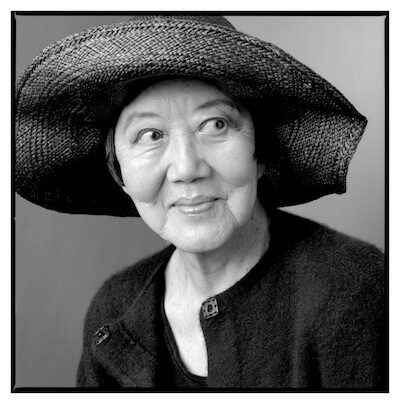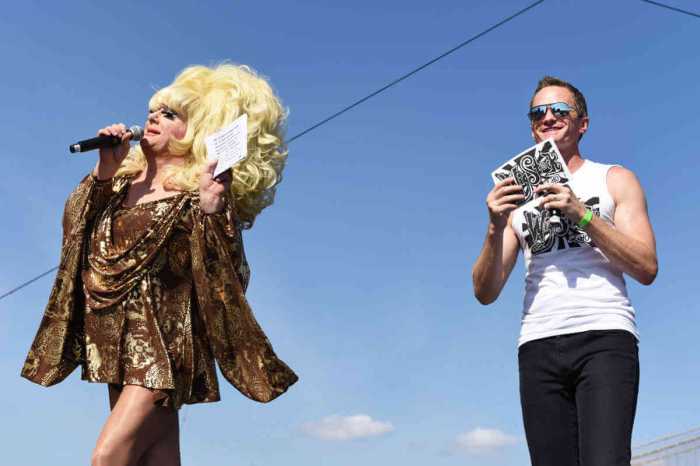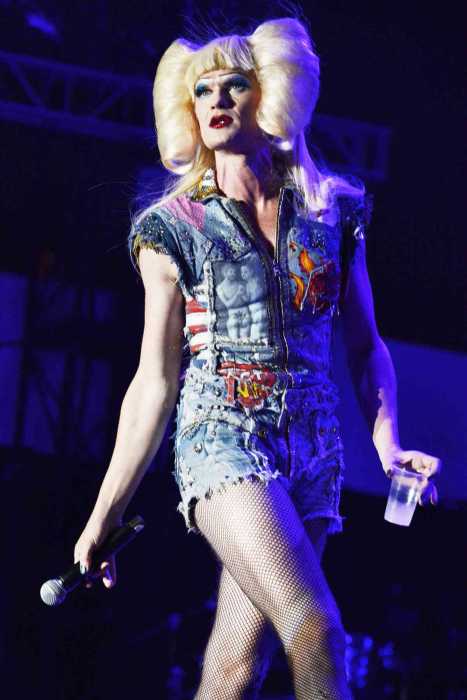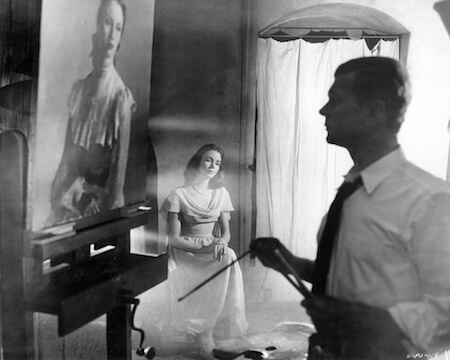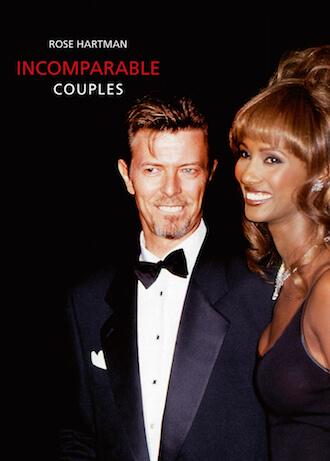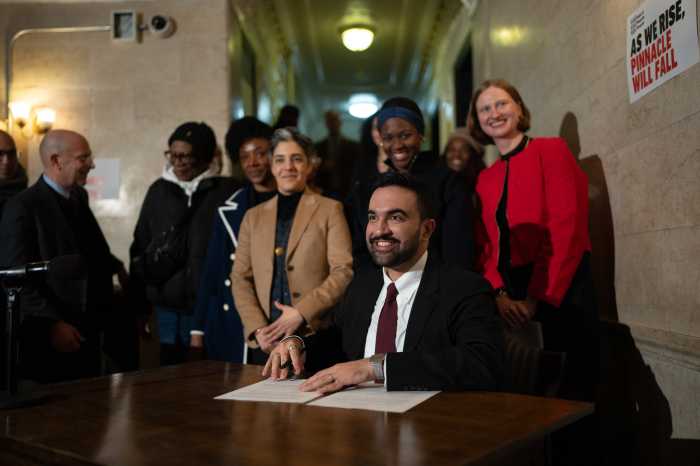Willa Kim. | CHRIS VANDEGUCHTE
A multitude of adjectives could be used to describe designer Willa Kim, who passed away in late December at the age of 99 on Vashon Island, Washington, but, somehow, “redoubtable” springs first to mind. She and I were both full-on Cancers, with no Earth in our charts, according to her. We shared the same tastes in most things, sometimes uncannily so, as when she told me she had the matching skirt to the Gaultier top I wore once.
We were close for a good long time. And then we weren’t. Doesn’t every gay man have a moth-and-flame experience with some high diva, whether famous or not? Some queens make it a life for themselves, becoming factotums for the famous. I just could not, the occasional singeing too great a price for me.
Though dressed by Sonia Rykiel and Tom Ford as she swanned through town with such hustling élan, she could be amazingly naive, even childlike – though that is the mark of so many great artists. “David, what is the ‘blues?,’” she asked me once, for she had been hired to design a Dance Theatre of Harlem ballet with the word in its title. This says so much about her for she was strictly – like Merman, like Gielgud, like any Broadway obsessed show queen in Hell’s Kitchen – all about the theater and, apart from politics, art, and fashion, with which she kept up assiduously, she only knew what she needed to, music never being her strong suit. Regardless, her ballet designs were typically brilliant, vividly hued, and moved like a dream.
The two-time Tony-winning costume designer was formidable, in fashion and friendship
She was pure Korean but American-born in LA, and although the Korean-American community embraced her as the living legend she was, her cultural roots meant little to her, preferring the Chinese/ Japanese aesthetic (as do I). I was shocked when I once called her “yobo” – the most common Korean form of endearment – and she had no idea what I was saying. “David, what is a ‘yawbo?’”
She could be the most fun – when you were out with her, Manhattan literally glittered in high-low situations. New Year’s was special, indeed, with her, and she got me into legendary gatherings at Betty Comden’s (with its photos of Bernstein and Judy Holliday atop the baby grand, while the hostess sequestered herself in her bedroom watching a football game, attended to by a solicitous Wendy Wasserstein), Tommy Tune’s (where Lauren Bacall refused to leave her seat on his terrace for fear of encountering an all-too-eagerly awaiting Sylvia Miles, and Al Hirschfeld first beheld the vision that is Amanda Lepore. “Wouldn’t she make a great drawing?” I asked him. “She’s already drawn.”) At an all-female lunch celebrating Kim, the divine Tony Walton gave a brilliantly effusive speech that beautifully nailed her and mentioned what a thrill it was “for me and David to be honorary ‘Women of the Theater’ today.” She was always ready for adventure and to party – and the last to leave if the vibe and chatter were right, which they usually were.
That childlike thing arose in a different way at a Ballet Hispanico opening night fête when she noticed that one of the achingly young dancers had a tongue piercing. “Let me kiss you, to see what that feels like,” she said. (Or was it so innocent? You’ll notice it was “let me” not “can I?”)
Having worked with or met nearly everyone, she was a marvelous, witty raconteur, and, being completely her own indefatigably self-directed person, she could be spectacularly irreverent, summarily dissing certain work of Walter Plunkett and Cecil Beaton, for example. And, as most who knew her can attest, she was usually right.
I had a thrilling, off-the-cuff moment with her once when, driving back from the Wadsworth Atheneum, we swung into Hartford for the opening night of a play starring Estelle Parsons, whom she had dressed. We went directly into the star dressing room to see Parsons, completely transformed into the wealthy, chic character she was playing, in Willa’s all-black cocktail frock and turban. But no jewelry, and Parsons had none of her own to wear. In a trice, Willa ripped off the bracelets – a Peretti and some deco bakelite – on her wrist and clasped them onto the actress, who went onstage for the curtain, completely dressed.
She won Tonys for two recreations of the 1920s-30s era she adored most: “Sophisticated Ladies,” where she had to tell the gorgeous Amazonian Phyllis Hyman to put down the fried chicken wing as the bias cut satin she was fitting on her was $500 a yard, and “The Will Rogers Follies.” On the latter, she ripped of Adrian’s ostrich-trimmed “Dinner at Eight” negligee for Jean Harlow (when she stole, it was from the best) and turned then dancer/ now choreographer-director Jerry Mitchell completely out as an Indian, barely covering his nakedness with a few strips of leather and some feathers. Mitchell later told me that designer Valentino was so taken with him after the show he sent him a costly watch and an open invite to yacht with him in the Mediterranean. Mitchell re-wore the costume in his earliest efforts with the charity event he founded, “Broadway Bares,” as well as a more recent comeback strut across the stage of Roseland.
Kim’s long, rich life divulged constant piquant surprises, stories of people you’d never imagined she’d known – like a brother who was among the most decorated American officers of World War II, or how her very first job as an assistant designer was making the paper patterns for the mink skirt that Ginger Rogers wears in “Lady in the Dark.” Before she ever designed, she told me, she was a chorus dancer in some Hollywood movie I’ve never been able to track down.
If you watch the film “Blood on the Sun,” you will have an idea of her incredible personal style because young designer Michael Woulfe dressed Sylvia Sidney’s Eurasian character in looks he copied from Willa’s wardrobe. When I was curating “Stage Struck,” a show about theater design at the Leslie-Lohman Museum, I went to her breathtaking Upper West Side seraglio to see what she had. So typical, Willa pulled out from the bottom of a closet, unseen for decades, her mentor Raoul Pène du Bois’ original sketches for Merman’s “Gypsy.”
At a dinner party she threw, one madly oenophile guest espied rare vintage bottles she had lying about. When told she’d had them for years, he insisted she crack open a particularly valuable one. She did – but it was so old it had turned to black powder. Her enflamed guest insisted on her opening all the others, which had languished chez Kim for decades. All powder.
She could be ruthless – her nickname in the industry was “Killa Whim – and though I don’t want to believe the story of how she baked live turtles for their shells for a belt accent, I feel she was capable of that. This ruthlessness – doubtlessly a survival mechanism necessary in her field, along with inordinate generosity to other designers and vice-versa – made her completely unsentimental. She was not a fan of tragedy or being depressed in any way. Was that a particularly Korean thing of her generation? My Dad was like that, too, never down or sad a day in his life. When a very old and dear friend mourned his lover of decades for what she thought was an inordinate amount of time, Kim was beyond curt with him. In a way that made him definitely rethink her, as I had to.
She was way rich and beyond cheap. Ask anyone who knew her. In the most severe weather, taxis were still anathema to her. It was all about the bus or subway, no matter how long the wait. When it came to splitting a check, it was down to the penny; she would charge interest on loans to friends. A close mutual pal literally gagged when I once told her that Willa had taken me for supper at Cafeteria. “She paid?” When her “Romeo” ballet by MacMillan and my clothes being exhibited in the disco exhibition at the Museum of Pop Culture in Seattle coincided time-wise, we went out there and road-tripped a lot, driving in the pissing rain to Vancouver, where I caught a glimpse of her passport and was awestruck by her age, something she’d be most displeased to see mentioned in her obits. At the disco opening night party, she was my guest but she had a guest list of plus-five of her own. On our road trips, she never contributed for gas or paid for a meal. Until at a diner breakfast, I said, “Willa, you can pick this one up, right?” (Probably the first to ever do so. I am Korean, too.)
As with all great artists, she was greedy, too. For life, fun, pretty things and, especially, food – when she remembered to eat. “David,” she once said. “I enjoy food much more than you do!”
But she was, for the most part, truly worth it. In Manhattan, Seattle, the Pines, she was roaring good company and always, visually, a true work of art. She was an uncanny mix of the most exquisitely sensitive – in her work, personal aesthetics – insensitive. Her bluntness could be ferocious, as when once, in the company of others, I was musing aloud about having an Italian getaway place, she said, “David’s a pauper.” An overweight friend, one of her closest, once said she needed to get a dye job desperately, as her black hair was showing its white roots. “Oh don’t!” Willa cried. “You look like Mount Fuji!”
Kim aspired to being a fine painter. She stopped talking to a dear friend for years after she removed and took home a painting she had done and given to that friend right off the friend’s wall during a party when she thought no one was watching.
Now what are you gonna do with a dame like that? But it was all sure, rich fun while it lasted. I do wonder what became of the priceless mechanical toy collection she’d acquired from her collector/ writer husband, Billy du Bois.
Contact David Noh at Inthenoh@aol.com and follow him on Twitter @In_The_Noh.

